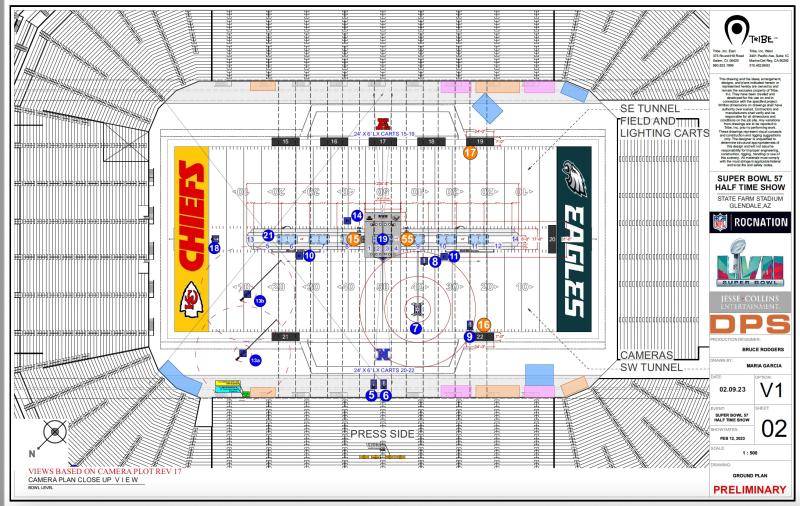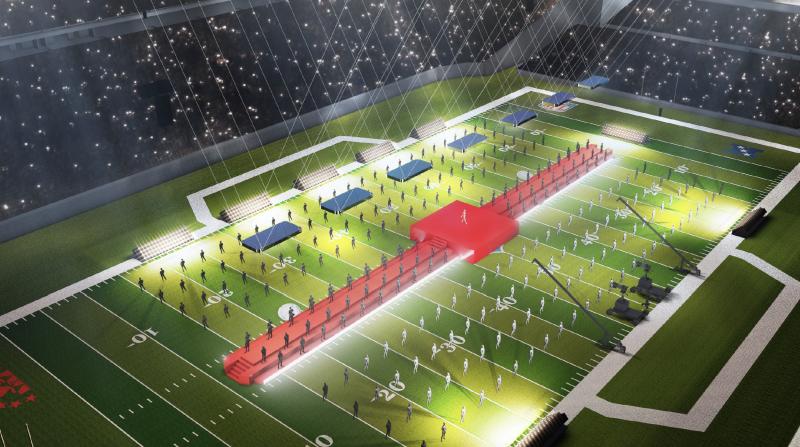Broadcast live from State Farm Stadium in Glendale, Arizona on Sunday, February 12, 2023, the Apple Music Super Bowl LVII Halftime Show featured Rihanna on an elegant red set designed by Bruce Rodgers of Tribe, Inc and built by All Access, with flying platforms by TAIT, all dramatically lit by Al Gurdon. Live Design chats with Rodgers on the various aspects of this challenging production.
Live Design: What was the brief for this year's production design and when did you get started on the project?
Bruce Rodgers: Our creative process starts about two to three months before the artist comes on board. We study the field and stadium structural systems, tunnel access, audience sightlines etc. to gather as much insight as possible before diving into the show design. We try to identify opportunities each stadium provides for an exciting show before the artist is ever announced. For example at Super Bowl XLIX with Katy Perry, (at this same stadium) we presented her a concept for field projection that she adopted as her main creative.
LD: Specific challenges due to the stadium configuration?
BR: The field is always a design factor, especially at State Farm Stadium in Glendale, AZ where the grass field is on a giant mobilized tray that tracks entirely outside to be cared for and watered in the Arizona desert sunlight. A healthy field is the number one rule for a safe and exciting game, and athlete safety as relates to the condition of the field before, during and after the halftime show is the most important factor in our design process.
Because of this the NFL presented us with very important guidelines about the size of the show we were allowed to put on the field. They proposed limiting rehearsals, and lowered weight limits for our field carts and cameras and size of performing cast. To accommodate these needs meant thinking differently in big ways. For the first time all ATK field audio carts would be rigged from the roof and the cart count total which was normally around 48-54 carts and cameras would be limited to 24 total carts and cameras! It was obvious we needed to create a minimal design compared to past shows. Our single tunnel access dictated the length and width of any field carts we might decide on using.
And because we had designed the overhead projection rig for Katy we knew the roof structure over the field was strong enough to hang massive amounts of weight.

LD: How did you collaborate with Rihanna's team, Al Gurdon, etc?
BR: When Rihanna was announced to us, we were introduced to her creative team that included her choreographer Parris Goebel, designer Willo Perron, manager/exec producer Jay Brown, and her tour and production managers Joseph Lloyd and Jason Milner. Combined with our team that included our executive producers from Roc Nation, Jesse Collins Entertainment, Dave Meyers with DPS, director Hamish Hamilton, associate director Cam Whitelaw, and LD Al Gurdon, we studied the NFL limitations and stadium realities, and out of that came the concept that the world saw on Super Bowl LVII Sunday! The concept was a very minimal design but a very expensive and technical endeavor, and over the course of four months the entire team studied ways to make it more affordable and practical, while being faced with technical rehearsal needs for a massive cast of dancers that rehearsed in two cities. Without Willo and Parris I'm not sure how we could have gotten all the cost approvals along the way! But thankfully in the end we managed as a team to put less carts on the field, and a few flown carts in the air which made the NFL happy and allowed us to provide a spectacle again on Super bowl Sunday!
LD: What was the impetus for the flying platforms from Tait?
BR: After the concept was in place it became my job to turn the design the idea into a reality and find ways to get it on and off the field in time. This took the expertise of two incredible set shops, a small army of designers, engineers and architects, staging experts and lot's of faith from our producers and the NFL that we could make it work. Long-time half time show staging fabricator All Access was responsible for the record 80-yard-long field stage while Tait Towers handled the seven flying elements. It was a ground and air concept never before attempted for a halftime show that requires an install of around seven to eight minutes and a strike in seven. But because the performance at 13 minutes, 30 seconds was longer than the optimal show time of 12 minutes that most artists play, we had to find ways to trim our timings by less than normal. On show day we installed in 6 minutes and struck the show off the field in 5 minutes 20 seconds. Which is a testament to the hardest working most professional staging experts in the business, a group that we are proud to be part of. A lot of attention has gone to the amazing flying platforms by Tait because of that wow factor, but without the All Access RED stage getting in place in 4 minutes 20 seconds, the flying platform dancers could not have loaded in time for the show to begin. I'm happy we had both shop teams to help us over the goal line! The result was a epic/minimally designed Halftime show that showcased incredible dance and a rockstar who was with child as it turns out. Lots of people to thank for the show's success not to mention the whole hard working production but also the NFL and Apple Music for support and encouragement.

Live Design: Why red and white?
BR: Design-wise I have to give Willo credit for the safety red color of the field stage. It looked great and worked well with the Fenty-designed white dance costumes. The mirrored finish of the flying platforms were a joint venture with the amazing team at Tait who managed to install an amazing rigging system that worked without flaw on show day. PixMob, PRG lighting, and Al Gurdon's lighting design were impactful and striking, making the staging glow and performers pop. Hamish's camera direction and camera team set a new mark in extreme live music television and our producers kept everything on track again resulting in another memorable Halftime show. One other credit should be paid in this massive group of amazing show business professionals and that is the stage manager Gary Natoli and his team, and Cap Spence and Tony Hauser, staging supervisors who somehow guide the mayhem of the install and strike with such finesse in the heat of stress that is impressive to watch.
Live Design: From your point of view what made this a successful show?
BR: From my point of view, this show is a major success because it did what is sometimes hard to do with a televised performance. Everyone in the live stadium audience could see Rihanna and her team perform. They got to witness her take flight up into a sea of amazing pyro made possible by the pros at Pyrotechnico and they got to watch how we make our kind of show business work. To me the live audience experience translates directly to the tv audience, something I learned on my first halftime show starring Prince in 2007. Nothing compares to a live performance, especially the Super Bowl Halftime Show.